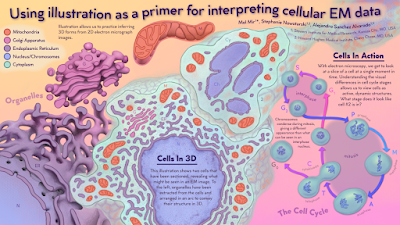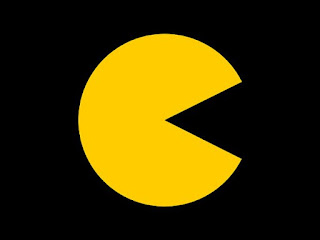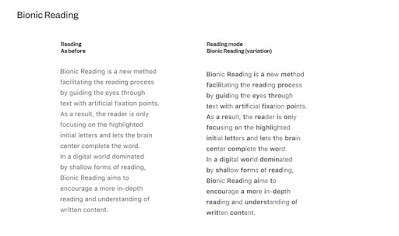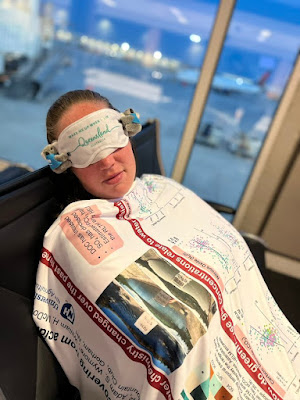Lots of great posters shown in winners of the 12th International Meeting on Visualizing Biological Data. Special congratulations to Mol Mir for the Best Scientific Poster award with this:
Excellent use of colour and illustration here!
• • • • •
Occlusion Grotesque is a typeface designed by a tree.
Fascinating project from Bjørn Karmann all round. Check out the whole post.
• • • • •
Sanjay Manohar shows that 3-D graphs shown as flat, static illustrations have an ambiguity problem:
Another solution besides drop lines is to present the graph as a stereo image.
• • • • •
Because of the attack on Ukraine, some popular typefaces –like Times New Roman – have been blocked in Russia. Hat tip to Peter Singer.
• • • • •
Tristan Long makes probably the nicest looking department seminar posters you’ve ever seen. They’re so nice, they got turned into a colouring book.
Hat tip to Ryan Gregory.
• • • • •
Dawn DiPeri has an open access – which is to say, free – book on graphic design, aimed at instructors. It’s titled Graphic Design for Course Creators.
I learned about this book on the Lecture Breakers podcast (episode 122, the one right after mine).• • • • •
A new-to-me suggestion to make small groups discussions inviting to others.
The Pac-Man Rule
The rule is:
When standing as a group of people, always leave room for 1 person to join your group.More memorably, stand like Pac-Man!
From Eric Holscher, with a hat tip to Leonardo Collado-Torres.
• • • • •
Some neck craning seems to be required to read the poster spotted in the background of a conference snapshot:
It appears someone confused landscape dimensions and portrait dimensions. Could be conference organizers, could be poster creators, could be someone else.
• • • • •
An interesting typesetting effect that someone called “bionic reading.”
But this is only one sample. It’s not clear what is causing this effect. The sample on the left is pretty light weight text, and maybe it’s just more bold.
From Christophe Pasquier. Hat tip to Moritz Stefaner.
• • • • •
New to me paper on the way colour combinations can signal emotions.
Bartram L, Patra A, Stone M. 2017. Affective color in visualization. Proceedings of the 2017 CHI Conference on Human Factors in Computing Systems. Denver, Colorado, USA, Association for Computing Machinery: 1364–1374. https://doi.org/10.1145/3025453.3026041Hat tip to Lisa Charlotte Muth.
• • • • •
This month’s best re-use of a poster, from Allison Herreid:
Hat tip to UNH Research.
• • • • •
It feels premature since the end of the pandemic is nowhere in sight, but Schreiner and Badawi debate whether research conferences should remain virtual after the pandemic ends. Excerpt from “Stay virtual” position:
(V)irtual meetings can be designed to cover all aspects of scientific and networking important for conferences. ... (I)t seems that the virtual conference is here to stay, at least as some component of all future conferences.
And on the “No more virtual” position:
(T)he most critical challenge for purely virtual conferences is the building of networks and the honing and synthesizing of new ideas, most of which takes place in animated conversations in front of posters, in serendipitous meetings in the corridors, and in the bar or over dinner. ... The sooner we are meeting face-to-face again, the better.
Schreiner LJ, Badawi R, Baldock C. The post-COVID future of research conferences should be virtual. Physical and Engineering Sciences in Medicine. In press. https://doi.org/10.1007/s13246-022-01138-y
• • • • •
Animate Your Science has a post on creating a poster template.
But honestly, this isn’t so much about creating a “template” as it is doing the simple first steps towards laying out a poster. Set the paper size, set up a colour and font schemes, etc.
• • • • •
I will be vain and end this month with a link out to my own Twitter thread analyzing one of the best selling posters of all time (by the Hildebrandt Brothers) and the lessons it has for academics.
It was May the Fourth

















2 comments:
The bionic reading reminds of Spritz, an app that came out in 2014 that purported to help people read at ~500 words per minute or more. It did so by firing one word at a time with a very particular alignment between successive words. Most Google search results for Spritz still point to articles in 2014 suggesting that it was a lot of hype that didn't take off. I wonder if bionic reading will have the same fate?
The Bionic reading reminds me of a Chrome Extension I use called Beeline which colors text different colors to help you focus on it, for speed reading.
Post a Comment